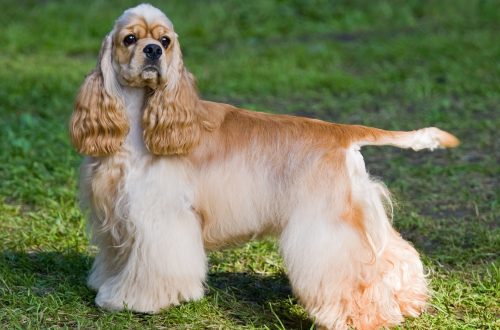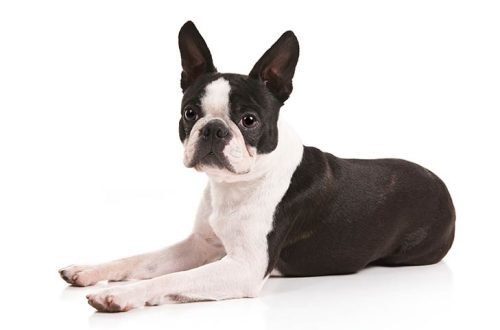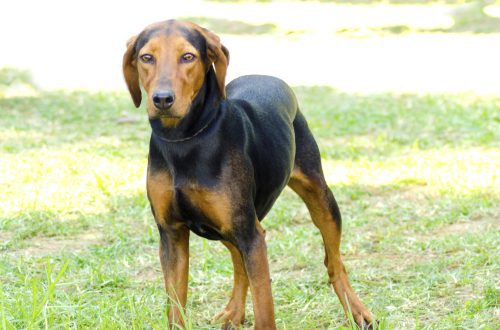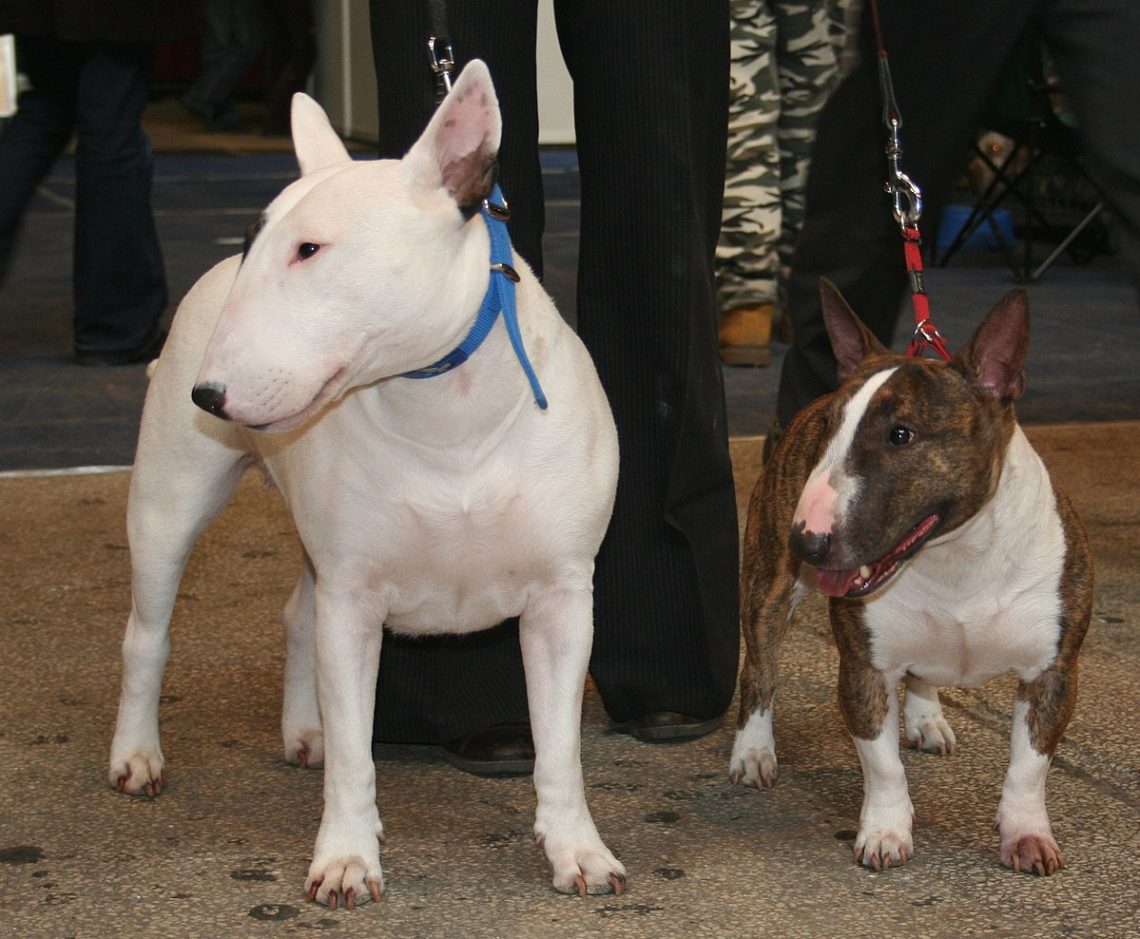
Miniature Bull Terrier
Other names: minibull , miniature bull terrier , pygmy bull terrier
The Mini Bull Terrier is a British breed of dog, descended from the Standard Bull Terrier, with a more compact build.
Contents
- Characteristics of Miniature Bull Terrier
- Basic moments
- History of the mini bull terrier breed
- Video: mini bull terrier
- Mini Bull Terrier Breed Standard
- Personality of the miniature bull terrier
- Education and training Miniature Bull Terrier
- Maintenance and care
- Health and Diseases of Mini Bull Terriers
- How to choose a puppy
- mini bull terrier price
Characteristics of Miniature Bull Terrier
| Country of origin | UK |
| The size | Small |
| Growth | 25-35 cm |
| Weight | no more than 8 kg |
| Age | 12-14 years |
| FCI breed group | Terriers |
Basic moments
- The Mini Bull Terrier is a very sociable breed that cannot cope with loneliness, so it is not recommended for keeping busy people and single owners.
- The friendliness that a dog shows towards a person does not extend to pets, which are severely bullied by mini-bull terriers.
- It is desirable that a person with experience is engaged in dog training. The breed is distinguished by independence and stubbornness when it comes to things that are boring, according to its representatives.
- Dogs do not tolerate cold climate very well, so in winter and autumn, the minibully will need insulated clothing for walking.
- The breed is ideal for people who do not want to spend time caring for their pet’s coat. Dog minibulls shed poorly and need only occasional brushing.
- Miniature Bull Terriers are undemanding to the dimensions of housing and easily adapt to living in ordinary apartments, provided that they are well and productively walked.
- Minibulls make excellent companions and very mediocre guards, so for serious protection of housing and property, it is better to choose a different breed.
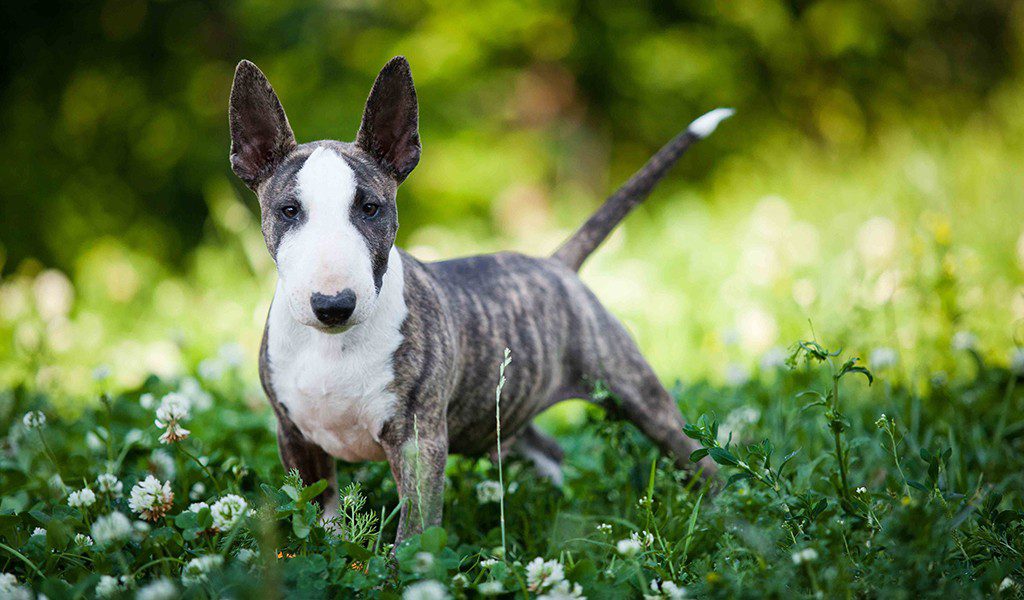
The Mini Bull Terrier is a groovy gambler and fidget, whose willfulness cannot be suppressed. Good-natured to humans and tough on any small animals, this egg-headed energizer has remarkable intelligence. But the minibull prefers to use his high mental abilities exclusively for personal purposes. In studies, the dog is more likely to pretend to be a charming “incomprehensible” or turn on the mode of an obstinate leader than to agree to follow strict rules. Yes, the minibull is trainable and manageable, but he is not a fan of the impeccable execution of commands and will always prefer sports exercises to classes, or better, a game.
History of the mini bull terrier breed
Miniature and standard bull terriers have common ancestors and remain the closest relatives themselves. Basically, the breed was bred by the selection method, since puppies were always born in the litters of standard bull terriers , which differed from their counterparts in more modest dimensions. At first, undersized animals were regarded as plembars, until British breeders came up with the idea to form an independent breed from them.
In 1914, the tiny dogs, dubbed Toy Bull Terriers, were shown for the first time at a London dog show. True, further breeding work came to a standstill: enthusiasts who began to breed animals were confused by the fact that dwarf individuals gave defective offspring, and even with a bunch of genetic ailments. After working on the mistakes, the breeders decided not to get carried away with the extreme characteristics and brought out slightly larger dogs, inferior in size to standard bull terriers , but superior in size to toy dogs. Representatives of this species were called miniature bull terriers.
In 1938, the Mini Bull Terrier Club began its work in the UK, and just a year later the breed received recognition from the English Kennel Club. It is worth noting the fact that the dogs bred in this time period were standardized not by weight, as was done earlier, but by height. In America, the first “fan club” of the breed opened in 1966, while registration in the AKC of miniature relatives of the standard bull terriers began only in 1991.
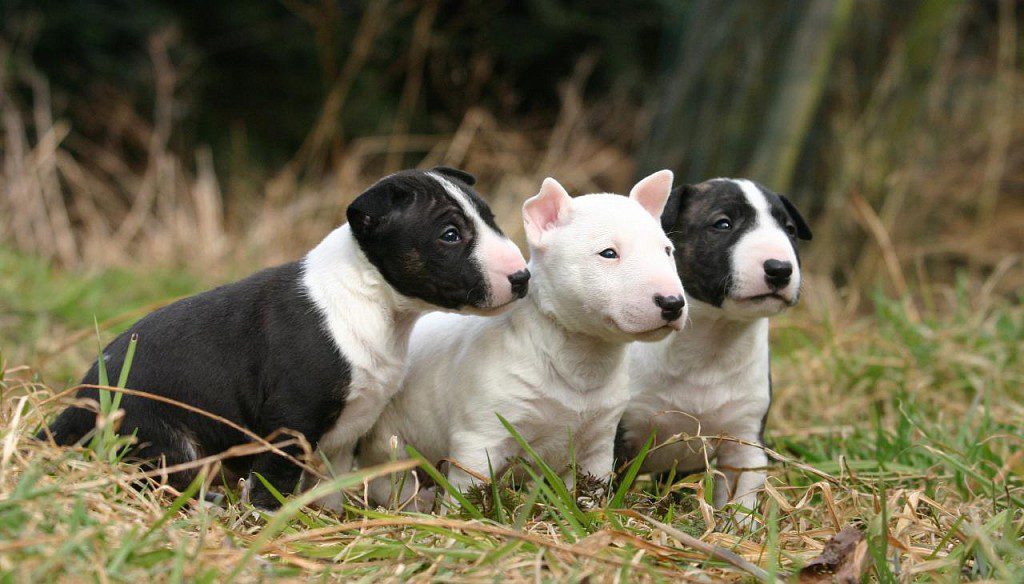
Animals entered Russia in the 90s, when fighting dogs became popular among crime bosses. Not that Bull Terriers were especially bloodthirsty, but due to their specific appearance, they immediately became in demand. As for the mini-bull terriers themselves, they, first of all, fascinated the owners of Russian standard apartments. There was not much space in such housing, so the minibull became an excellent “compromise” for dog lovers who want to have a formidable-looking, but undemanding pet at the same time.
Video: mini bull terrier
Mini Bull Terrier Breed Standard
Externally, the miniature bull terrier is a reduced copy of the representatives of the standard line of the breed. Muscular, with pronounced bone strength and egg-shaped heads, minibulls are the type of super-charismatic pets that will always attract the attention of others. The lower limit of growth for a mini bull terrier is 35.5 cm. In this case, the dog may be slightly above the set bar, but in no case below. Weight restrictions in the case of this breed do not apply, but it is imperative that the dog looks harmonious. Fatty, as well as overly lean individuals, will not make an exhibition career.
Head
The deep, evenly filled head of the Miniature Bull Terrier is distinguished by an elongated profile and an ovoid shape. The top of the skull is of a flattened type, the surface of the muzzle is without depressions and excessively raised areas.
Nose
The bridge of the nose is curved down at the tip. The nostrils are normally open, the lobe is evenly colored black.
Teeth and bite features
The lower jaw looks especially deep and prominent. Strong teeth stand evenly in rows, and the teeth of the upper jaw overlap the lower ones, forming a complete scissor-like closure (occlusion).
Miniature Bull Terrier Ears
The Mini Bull Terrier has thin and neat ears, set close together. The ear canopy is in a vertical position, the tips of the ears point straight up.
Eyes
The eyes of mini bull terriers are triangular in shape, which makes them look very narrow and small. The iris is colored dark brown, often close to jet black. An important ratio: the distance from the eyes to the occiput should be less than from the nose to the eyes.
Neck
The beautifully arched and long neck of the miniature bull terrier is covered with dense muscles. There are no folds. The base is noticeably thicker than the upper part of the neck, but the transition between them is smooth.
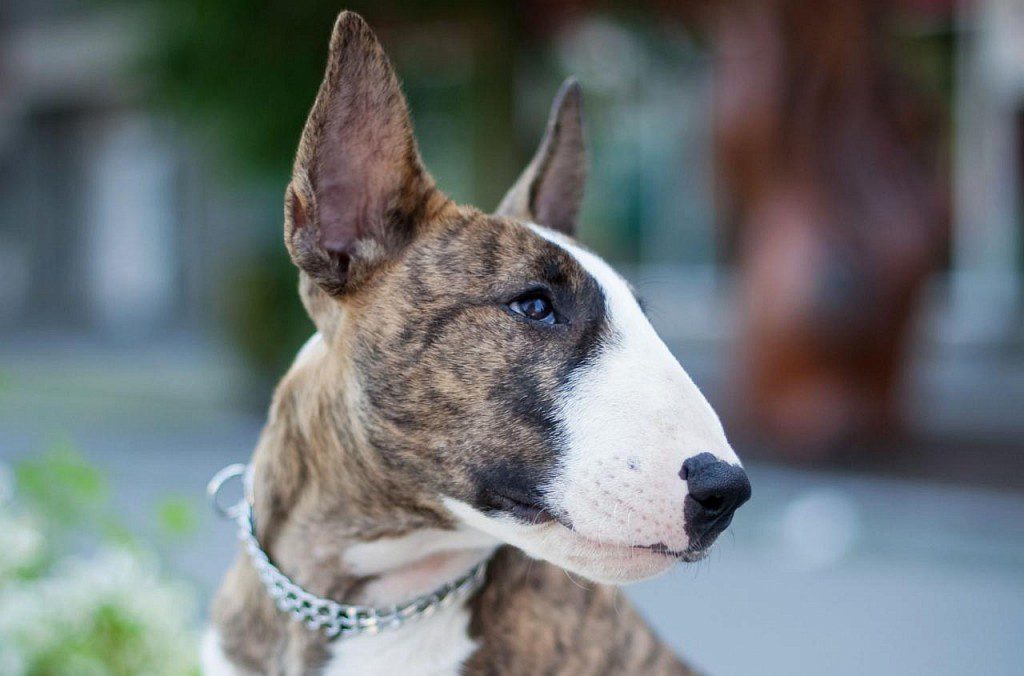

Frame
All representatives of the breed have compact bodies with strongly curved ribs. The gap between the withers and chest is very deep. The back is short, convex in the lumbar region and flat in the area behind the withers. The lower abdomen forms a smooth curved line, maximally matched in the area of the inguinal zones.
limbs
The thoroughbred mini-bull terrier stands confidently on strong, muscular legs, for which a parallel posture is typical. The length of the limbs and the depth of the chest have the same meaning (only for adults). Not overloaded oblique shoulder blades fit closely to the sides, forming right angles with the shoulders of the dog. The forearms are formed by strong rounded bones, the pasterns are fixed in a vertical position.
The hind legs of the mini bull terrier are impressive hips, well-defined knee joints and strong lower legs. Hocks with normal angulations, metatarsus shortened but strong. The paws of the animal are small, rounded, fingers with a clear bend. The Miniature Bull Terrier moves flexibly, without stiffness. When trotting, all four legs move synchronously, when accelerating, the paws are placed closer to the center.
Miniature Bull Terrier Tail
The short tail of the Mini Bull Terrier is set low. The tip of the tail is thin, the base is thick.
Wool
Short, moderately coarse hair has a pleasant sheen. The undercoat of the breed appears seasonally, more precisely, closer to winter.
Color
Mini Bull Terriers can be either completely white or colored. Individuals of a solid white color may have spots on the head and pigmented skin. Colored Bull Terriers come in black brindle, fawn, red, and tricolor. Prohibited color options: speckled on a white background, brown-liver, blue.
Deficiencies and defects of the exterior
The list of defects in the appearance of the breed is the same as that of standard bull terriers . Individuals with bright eyes, speckled earlobe, loose and folded skin, twisted joints, long hair and non-standard colors cannot claim high exhibition marks. Serious exterior defects also include cryptorchidism, depigmented skin of the nose, deafness and spots on the body of white dogs.
Personality of the miniature bull terrier
In mini-bull terriers, there is practically nothing left of the bloodthirsty ancestors bred for dog fighting and rat-baiting. Today’s representatives of the breed are positive livestock who love outdoor games, running around and various pranks. Of course, they are not always goodies and are not averse to being stubborn in order to test the master’s endurance for steadfastness, but aggression is not characteristic of the breed.
Mini bull terriers are completely unsuitable for the role of apartment watchmen. The maximum that a dog can give out when a stranger approaches is a warning bark. However, this action occurs only when the pet is grossly provoked. The minibull hospitably meets benevolent strangers on the threshold, trying to sycophantly lick the hand. But in relation to representatives of the fauna, the genes of brutal ancestors are still making themselves felt. For this reason, most dog management manuals strongly advise against letting the mini-bull terrier off the leash for walks – the four-legged bespredelnik will rush off after the first cat, pretending not to hear your shouts at all.
Do not keep domesticated rodents and a dog in the same area. In a permanent confrontation, someone alone will survive, and this someone will definitely not be a hamster. To whom mini-bull terriers are able to make concessions, it is children. Firstly, because in their hearts they consider them dumber than themselves, and secondly, because it is the kids who can satisfy the dog’s need for games. The worst test for the breed is loneliness. Minibulls are basically not adapted to while away the hours waiting for the owner, so for any loner with an irregular work schedule, the dog will quickly turn into a problem.
Education and training Miniature Bull Terrier
Cynologists classify miniature bull terriers as highly intelligent, but difficult to train breeds. As a result: it is better to immediately lower the bar of requirements for “egghead meteors”. Take into account the fact that all representatives of this family are pronounced dominants who do not tolerate when they are rigidly put in their place. In this regard, it will be necessary to maintain a balance of relationships, namely: to show the dog that the leader in the house is still the owner, but at the same time avoid authoritarianism in communication.
Minibulls are easily motivated to feats with praise and tasty bonuses, so for each successfully completed task, the pet needs to be positively stimulated. Too much relying on the high intelligence of the breed is also not worth it, so in the process of learning commands, do not be lazy to help the dog. For example, when giving the order “Sit!”, lightly press your hand on the back of the animal, forcing it to fall on its paws.
It is better to present new tricks in an entertaining way: mini-bull terriers are still gamers. But to expect perfect execution of commands from representatives of the breed is a meaningless exercise. Miniature bull terriers have not got the perfectionism of service dogs, so accept that your requirements will not be fulfilled immediately and not quite as we would like. It is advisable to demand impeccable adherence to the rules only in everyday situations, when the comfortable life of others depends on the behavior of the pet.
As for special training programs, it will not work to “jump” above the UGS course with a miniature bull terrier. But with this friend you can practice in sports disciplines. Best of all, the breed is given jogging for the owner’s bike, agility, pitch and go. But weight pulling, in which standard bull terriers are often involved , will not work in the case of their miniature relatives.
Ideally, the dog should be trained by the head of the family. It is better not to try to involve children in this business: the minibull, of course, is not averse to fooling around with them, but this does not prevent him from considering the children a cut below him. No physical punishment should be applied to even a dog that has pretty much shaken its nerves. If the dog is too loose, it is easy to rein him in with a stern look, taking away his favorite toy or depriving the delicacy that the pet was counting on. Just act in hot pursuit: it is useless to punish the minibull for torn wallpaper last week. The dog remembers just committed offenses and managed to forget about yesterday’s, so your claims will be taken as an unreasonable infringement of its rights.
Maintenance and care
The Miniature Bull Terrier is an ideal apartment dweller, able to live happily even in confined spaces. It is important to understand that the breed is not decorative. In order for the miniature bull terrier not to smash the home to shreds, you need to walk with it for a long and productive time. It is ideal to combine walks with useful activities, such as sports exercises. In the season, you can take the minibull with you for a picnic or hunting – dogs love to chase game.
If sports and trophy hunting are not suitable for some reason, you will have to think about how to unload the animal for a walk. The most popular options: harnesses with weights, jogging on loose sand and uphill. Do not forget about toys: with them, the miniature bull terrier takes the soul out of the house, which helps him to refrain from destructive games.
Important: playing sports, running with weights and other energy-intensive entertainment can be practiced no earlier than the puppy is 8 months old.
Hygiene
If you want to save on groomer services and hair care products, the minibull is your dog. The smooth, short coat of the breed has a dust-repellent property, and the scarce undercoat that grows by winter never forms tangles. You don’t have to run after the animal with a comb either: to maintain a neat appearance, it’s enough to collect dead hairs from the dog’s body with a rubber glove or brush once or twice a week. However, there are smooth wool and cons. For example, such a dog does not protect the minibully’s body from low temperatures very well, so for walking on frosty days you will have to get a warm overalls.
Short hair does not save from insect bites, which can provoke allergies. To prevent this from happening, use repellents, as well as protective blankets, during field trips with your dog. The claws of mini bull terriers are supposed to be trimmed once a month. Be sure to monitor the health of your pet’s eyes – remove the lumps of mucus formed in the corners of the eyelids with a clean cloth, which can be additionally moistened with chamomile decoction. For weekly cleaning of the ears, use hygienic drops or lotions.
Feeding
The basis of the natural diet of mini-bull terriers is lean meats (beef, rabbit, chicken), raw tripe, liver, low-fat sour-milk products and sea fish, cut to a fillet state. For safety reasons, the meat must first be frozen or doused with boiling water – this will help kill the eggs of worms and microorganisms that cause digestive problems. Porridge can be given buckwheat and oatmeal, but you should not get too carried away adding cereals to the diet.
Miniature Bull Terriers benefit from any vegetables except legumes and potatoes, as well as fresh herbs. It is better to give these products raw and finely chopped. 3-4 times a month, you can treat your pet with a boiled chicken egg. As a source of fiber, it is recommended to use special bran for dogs. Before giving them to an animal, bran must be soaked in kefir or broth and allowed to swell. Vitamin and mineral supplements for natural feeding are required. Only mini-bull terriers that eat industrial dry food do not need dietary supplements.
Health and Diseases of Mini Bull Terriers
The breed is plagued by only three genetic diseases, all of which are inherited in an autosomal recessive manner, that is, when both parents are carriers of the defective gene. The most common ailment among miniature boules is primary dislocation of the lens. The disease is treated surgically, but it is dangerous because in advanced stages it leads to complete blindness.
A very rare hereditary pathology is PAD, also known as lethal acrodermatitis, which manifests itself between the ages of 6 months and 2 years. A puppy with LAD is stunted, suffers from diarrhea and focal skin lesions on the muzzle and paws. Sometimes carriers of the disease have hyperkeratosis and lightening of the coat (with the exception of white individuals). Another hereditary disease of mini-bull terriers is paralysis of the larynx. What is characteristic: the pathology can manifest itself both by itself and due to mechanical damage to the throat (trauma, insect bites, tumors).
How to choose a puppy
- Trust only breeders who provide test results for both sires for genetic diseases.
- Carefully feel the puppy’s tail: it should not have knots and creases.
- Be sure to ask the breeder to provide a certificate of examination of the litter, carried out by a specialist of the breed club or cynological organization.
- Cynologists do not recommend taking too phlegmatic minibulls. As they grow older, they become even slower and harder to train. Always give preference to active and inquisitive kids.
- Don’t take the fattest puppy in the litter. Corpulent forms are not an indicator of good health.
- If you have little experience in training dogs, opt for a female puppy. Mini Bull Terrier females are always softer, more contact and learn faster.
- Specify how many babies the bitch feeds in total. The best option is 5-7 puppies. If there is more litter, most likely the mini-bull terriers do not have enough mother’s milk, which means that the offspring will not have the strongest immunity.
- Too small litters should be treated with extreme caution. Basically, a couple of puppies are brought by young female mini-bull terriers who give birth for the first time. A small number of babies in a mature dog may be the result of an intrauterine infection, as a result of which some of the puppies die, so it is undesirable to take an animal from such a parent.
mini bull terrier price
In Russia, there are very few registered nurseries engaged in breeding the breed. Perhaps that is why miniature bull terrier puppies are much more expensive than their standard counterparts. The average cost of a dog in the local pet market is 1200 – 1700$. Exhibition minibulls will cost even more tangible amount – from 2000$.





